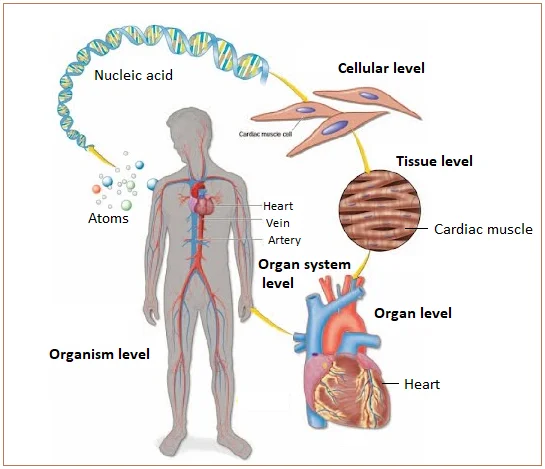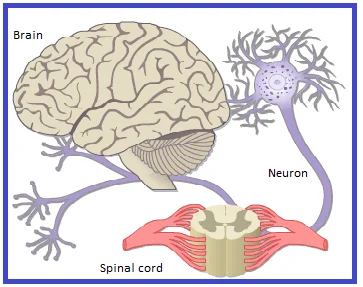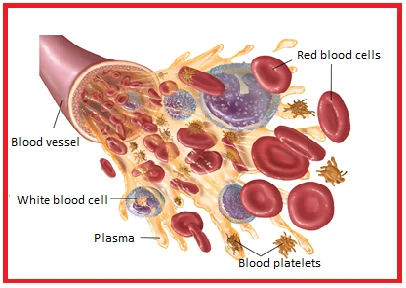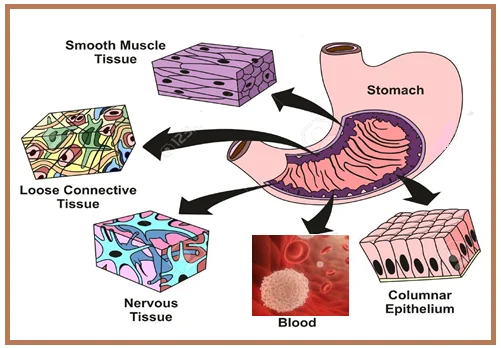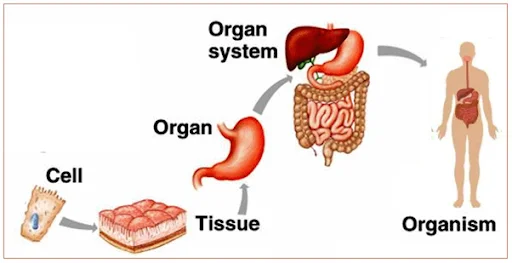- Written By
Swati_C
- Last Modified 29-01-2025
Different Levels of Organisation in Human Body: Definition & Hierarchy of Biological Organisation
Different Levels of Organisation in Human Body: The biological world is enormously diverse. There are a huge number of varieties of living organisms ranging from microscopic organisms to highly evolved complex organisms. Human beings are the most complex and highly evolved organisms that exhibit different levels of structural organisation.
It also serves as one of the important parameters for classifying human beings into a specific group. Moreover, different levels of organisation in the human body also facilitate morphological and anatomical studies to some extent. Let’s study in detail the different levels of structural organisation of the human body.
What is Structural Organisation in the Human Body?
Structural organization in the human body exhibits various levels starting from the simplest, i.e., the cell, to the complex one, i.e., organ system that altogether forms the human being. The hierarchical arrangement of different levels of organisation in the human body in accordance with the increasing order of structural complexity can be represented as follows:
Need & Importance of Different levels of Organisation
Highly evolved multicellular organisms like humans exhibit the highest degree of body complexity. However, in humans, the cell is the basic foundation stone of the structural body organisation. The cells are involved in the formation of different types of tissues that further constitutes the organ and organ systems in humans. The need of organ and organ system level organisation can be discussed as follows:
- The body of humans is highly complex. Therefore it is not possible to exchange the materials like gases, nutrients, etc., simply by diffusion and hence require specific organs and organ systems for specific functions and thereby fulfill the needs of each and every cell of the body to its satisfactory level.
- The organ and organ system level organisation facilitates the division of labour and therefore brings out the several life processes working together with their maximum efficiency.
Level of Structural Organisation
All living beings are made up of a fundamental unit called the cell. However, some organisms represent a single cell as the entire body, while some have a few or millions of cells that constitute the entire body of an organism. There are the following levels of structural organisation of living beings:
- Cellular Level Organisation: A cell is the basic structural and functional unit of all living beings. Each cell consists of different types of cell organelles, i.e., mitochondria, chloroplast (in plant cells only), endoplasmic reticulum, Golgi apparatus, lysosomes, microtubules, ribosomes, nucleus, etc. The organisms that are made up of only a single cell are called unicellular organisms and exhibit a cellular level of body organisation. Human beings are highly specialized multicellular organisms that possess different types of cells that constitute the tissues, organs, and organ systems. A few examples can be discussed as follows:
i. The neuron is the basic structural and functional unit of the nervous tissue that constitutes the brain and spinal cord. Each neuron is an elongated cell that consists of an axon, cyton, and dendron that is responsible for the transmission of nerve impulses.
Fig: Neuron in the Brain and Spinal Cord
ii. The red blood cells, white blood cells, and blood platelets constitute the fluid connective tissue blood and are designed according to their specific functions.
RBCs lack a nucleus, ER, and mitochondria to facilitate the transport of substances. WBCs are adapted to their function of phagocytosis.
Fig: Different Types of Blood Cells
2. Tissue Level Organisation: Tissue is defined as the group of cells that together perform specific functions. The organisms that consist of tissue-level body organisation are comparatively complex and more evolved than unicellular microscopic organisms. Human beings and mammals are highly evolved animals that comprises four different types of tissues that can be discussed as follows:
i. Epithelial tissue: The epithelial tissue forms a continuous layer over the surfaces of many other tissues. Consequently, it covers the external body surface and lines the visceral organs, body cavities, and blood vessels. This tissue is characterised by the absence of blood vessels.
The epithelial tissue can be classified into simple and compound epithelial tissues. Simple epithelial tissue comprises a single layer of epithelial cells, and those that comprise more than one layer of cells and gives a stratified appearance are called compound epithelial tissue.
There are four different types of cells that have been found in simple and compound epithelial tissue, namely, squamous, cuboidal, columnar, and ciliated columnar or cuboidal.
ii. Connective tissue: As the name suggests, connective tissue provides a structural framework and support to different organs forming an organ. Blood is the only fluid connective tissue in advanced animals that serves as a transporting medium.
There are eight different types of connective tissues found in animals, namely, areolar, adipose, white fibrous tissue, tendon, ligament, cartilage, bones, and blood.
iii. Muscle tissue: Muscle tissue consists of highly specialised contractile cells or fibres held together by connective tissue. These are thin and elongated cells and are often called muscle fibres.
In higher animals, these are found associated with the skeleton, walls of visceral organs, blood vessels, and heart, etc. According to their structure, location, and functions, there are three main types of muscles, namely, skeletal muscle, cardiac muscle, and smooth muscle.
iv. Nervous tissue: It is a special kind of tissue that is responsible for receiving, transmitting, and discharging various sorts of stimuli. It comprises two types of cells, nerve cells (neuron) and glial cells.
3. Organ Level Organisation: Two or more tissues are organised to form specific organs that are designed and adapted according to their functions. A few examples are as follows:
I. The stomach is a sac-like organ that consists of an inner lining of columnar epithelium, bound to smooth muscle tissue through loose connective tissue. The neurons present in the walls of the stomach facilitate the contraction and relaxation during peristalsis.
Fig: Different Types of Tissues Found in the Stomach
II. The urinary bladder consists of an inner lining of epithelial tissue, bound by various connective tissues to smooth muscles. There are neurons present throughout the bladder that controls the muscular contraction and relaxation during the urination reflex.
4. Organ System Level Organisation: Two or more organs coordinate their functions together to carry out one of the specific life processes such as digestion, excretion, respiration, circulation, reproduction, nervous and hormonal control, etc., and form an organ system. A few examples can be discussed as follows:
I. Human digestive system: It comprises the mouth, oesophagus, stomach, small intestine, and large intestine.
i. The mouth is designed to ingest and crush the food and also to mix the food with saliva.
ii. The muscles of the oesophagus perform peristalsis for transferring the food to the stomach.
iii. The stomach and small intestine are adapted for the digestion of food. The small intestine, in coordination with the pancreas and liver, completely digests the food.
iv. The inner muscular wall of the small intestine is designed to absorb the digested food.
v. The large intestine is designed to absorb the maximum amount of water from the food.
Fig: Hierarchical Structural Organisation of the Human Digestive System
II. Human Respiratory system: Nose, trachea, bronchi, and lungs are involved in the process of breathing and respiration.
i. Nostrils inhale the air from the environment, and cilia, and mucus lining check the entry of dust particles and germs to further move into the tubular passage.
ii. The trachea is supported by C-shaped cartilaginous rings that prevent the collapse of the tracheal wall and thereby facilitate gaseous exchange.
iii. The lungs comprise millions of alveoli that are made up of single layer squamous epithelial tissue. The epithelial lining allows the gaseous exchange between the blood and alveoli.
III. Human Excretory System
i. The kidneys, ureters, and urinary bladder altogether form the urinary system.
ii. The kidneys filter the blood, and the nitrogenous waste products reach the urinary bladder through the ureters. The urinary bladder stores the wastes for some time; these wastes are further removed from the body through the urethra. In this way, the three organs of the urinary system are involved in the process of excretion.
Summary of Different Levels of Organisation in Human Body
Biologists have estimated that there are between 3 million to 30 million species on the Earth. These organisms range from unicellular microscopic organisms to highly evolved complex multicellular organisms. Based on the structural body plan, there are five different levels of the organisation that have been studied in the human body, namely, cellular level, tissue level, organ level, and organ system level, and organism level of body organisation. The cellular level of organisation is the simplest, whereas the organism level of body organisation is the most advanced that is represented by highly evolved plants, animals, and humans.
Frequently Asked Questions on Different Levels of Organisation
Q.1. What are the five different levels of the organisation?
Ans: The cell, tissue, organ, organ system, and organisms are the five different levels of body organisation of living beings stating the body complexity of living organisms.
Q.2. What is the smallest and simplest level of organisation?
Ans: Cellular level is the smallest and the simplest level of body organisation.
Q.3. At which level of organisation is your heart?
Ans: The heart is composed of cardiac muscles (a type of muscle tissue) and thereby exhibits organ-level organisation.
Q.4. What is the highest level of organisation in a multicellular organism?
Ans: Organisms level organisation is the highest level of organisation in a multicellular organism.
Q.5. What level of organisation is the brain?
Ans: The brain exhibits organ-level organisation that is composed of nervous tissues containing millions of neurons.
We hope you find this article on Different Levels of Organisation in Human Body proves helpful. In case of any queries, you can reach back to us in the comments section, and we will try to solve them.











